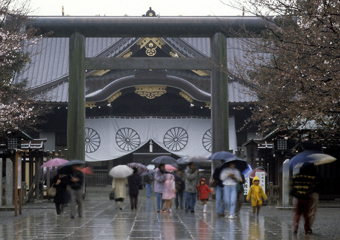Viewing the World Through Nationalist Lenses
It's important to be aware of how our nationalist views are perceived by the rest of the world. Japan's Yasukuni shrine is a case in point.
 On the anniversary this week of the end of World War II in the Pacific, members of the Japanese cabinet were not to be seen at the Yasukuni Shrine, the site in Tokyo that memorializes Japan's war dead. Official visits to the shrine have been a subject of controversy for years, largely because some of the leading war criminals from the Pacific war are among those enshrined there. No incumbent Japanese prime minister has visited the shrine in the last four years, but Japanese newspapers reported that this year was the first in which the entire cabinet stayed away from the August 15th observances commemorating the end of the war.
On the anniversary this week of the end of World War II in the Pacific, members of the Japanese cabinet were not to be seen at the Yasukuni Shrine, the site in Tokyo that memorializes Japan's war dead. Official visits to the shrine have been a subject of controversy for years, largely because some of the leading war criminals from the Pacific war are among those enshrined there. No incumbent Japanese prime minister has visited the shrine in the last four years, but Japanese newspapers reported that this year was the first in which the entire cabinet stayed away from the August 15th observances commemorating the end of the war.
While in Japan this spring I visited Yasukuni, spending most of my time at the war museum that is on the grounds of the shrine. The museum has some interesting hardware (such as the Kaiten human torpedo or one-man submarine, which the Japanese used for suicide missions), but it consists chiefly of displays telling the story (in Japanese and English) of Japanese involvement in wars since the Meiji Restoration of the 1860s. The story is told very much from a Japanese nationalist point of view. There are no blatant propagandistic distortions of the type I remember seeing in some museums in communist-ruled states during the Cold War, but it is a distinctly different historical interpretation than almost anyone outside of Japan, including Americans, would give to the events being described. Probably the foreigners most likely to be offended would be Chinese, with regard to the displays addressing how it was that Japan and China came to fight a war against each other in the 1930s.
The museum is a lesson in how much a particular nation's culture and experiences can color not only views of what is right or wrong and what is necessary or unnecessary but also basic history. The differences in perspective can be marked even for the closest of friends and allies. The transition of the U.S.-Japanese relationship from bitter combat in World War II to an extensive convergence of interests in the post-war years is one of the most wonderful such transitions ever. But the wonder of that transition and the Japanese moderation that has accompanied it make it easy to forget that even as reliable an ally as Japan can and does look quite differently than we do at some matters that, although they may directly concern the past, have relevance to important issues of the present.
The values and historical interpretations at the Yasukuni Shrine are not embraced by all Japanese. The boycott of the anniversary observance by the government of the left-leaning Democratic Party of Japan was a statement to that effect. But herein lies another lesson, which is that the elements in a foreign country that have been (or have seemed to be) our closest friends may be some of those most likely to have different perspectives from ours. Many in the Liberal Democratic Party, which has governed Japan for most of the post-war years and has furnished almost all of the statesmen who have been partners of the United States, are comfortable with the values and history enshrined at Yasukuni. (Liberal Democrats made their own visit to the shrine on the end-of-war anniversary.) The last sitting prime minister to visit the shrine was Junichiro Koizumi, the Elvis Presley fan who during his final official visit to the United States was rewarded for his cooperation with Washington by being taken to Graceland.
Yasukuni also shows how some peculiar national perspectives are a mixture of history, myth, and religion. The mixture is most obvious in the Shinto of Japan, but it arises in less clearly labeled guises in other nations.
The Japanese nationalist interpretation of World War II and associated twentieth century warfare in Asia is still a very sore point with China and South Korea (despite repeated Japanese apologies, renewed this week by the Democratic Party government). The United States does not today have a comparable bone to pick with Japan. Most of the lessons for us have more to do with remembering how other friends and allies may see things much differently from us because they are looking at the world through their own, peculiar nationalist lenses.
And perhaps the most important lesson is to be aware of how our own strong American nationalism furnishes the peculiar lenses through which we look at the world, resulting in perspectives that to others may be at least as foreign and even offensive as anything found in Japan. Some of our perspectives, like those represented at Yasukuni, are mixtures of history (especially the bloodier and more bitter parts of it), myth, religion, and even sacred ground. We have perhaps seen each of these elements in some of the debate over the proposed mosque near the site of the World Trade Center.
